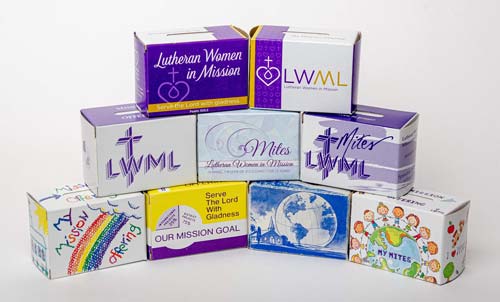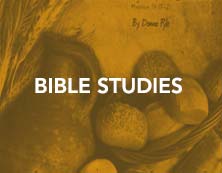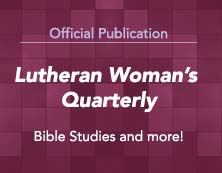Mite Explanation and History
Based on the Biblical account of the widow's mite (Luke 21:1–4), the Mite Box is intended for regular contributions of "mites" — offerings above and beyond the support given to congregations and the LCMS. Mite Box contributions amount to millions of dollars that fund district and national mission grants and implement the LWML program.
Mite Boxes, available from the district, zone, or LWML office, are distributed to every woman in a society, and often to each member of the congregation. Local groups submit Mite Box offerings to the appointed district officer.
The Widow's Mite
Jesus sat down opposite the place where the offerings were put and watched the crowd putting their money into the temple treasury. Many rich people threw in large amounts. But a poor widow came and put in two very small copper coins, worth only a fraction of a penny. Calling his disciples to him, Jesus said, "I tell you the truth, this poor widow has put more into the treasury than all the others. They all gave out of their wealth, but she, out of her poverty, put in everything — all she had to live on" (Mark 12:41–43).
Mite Boxes — How They Began
Perhaps inspired by the various "cent" or "mite" societies of the early 1800s, the Woman's Mission to Woman (Baptist) urged members in its first circular letter in 1871 to use their new Mite Box to raise funds. The entire family was encouraged to contribute. The garnet-colored paper box had an opening on the top and the words, "Woman's Mission to Woman," in gold letters on the side.
LWML Mite Boxes

Over the years, many Lutheran Ladies Aid societies used a box to gather funds in support of local and synod ministries. Under the original 1928 Lutheran Women's Missionary Endeavor organizational plan, each woman in every congregation would receive a Mite Box if she participated in the Ladies Aid. Receipts from the 92 Ladies Aid societies totaled $6651.31 in 1930.
The Lutheran Women's Missionary League, formally recognized by the Lutheran Church—Missouri Synod in 1942, required by the newly adopted constitution and bylaws, that 25% of all missionary contributions be given to the national organization, shared from the districts.
At the 1953 convention, delegates reaffirmed the policy of raising funds only through voluntary offerings. Instead of "mite boxes" some societies called their ingathering devices "blessing boxes" or "mission boxes" or "thankoffering boxes." The first Mite Box design had space for districts to imprint local messages. In publications and speeches, Leaguers were reminded not to just tuck their Mite Box away out of sight and then on the day of the meeting take out a dollar bill, put it in an envelope and hand it to the secretary. Among the suggestions offered were:
- Put your pennies in the box at the end of each day
- Say "thank you" with an appropriate amount whenever calamity or misfortune has been averted
- Empty all your loose change from your kitchen coin bowl into the box on meeting day
Throughout the decades, Lutheran women have stepped out in faith, setting goals and trusting God to move the hearts of His people to give generously to LWML to proclaim the Gospel.

Times and Mite Boxes Change
Mite Boxes have changed in color and design over the years, but what has never changed is the dedication of freely given offerings for the purpose of reaching out to others with the Good News of Jesus Christ. Districts still retain 75% of mite offerings for the work of the LWML at that level. National mites fund over $1 million in mission grants. See Mission Grants for the current grant recipients and payments.
View the Mite Box History video to see how the Mite Box has changed from 1942–2019.










